Heating radiator connection diagrams: an overview of the best methods
Are you planning to change the heating appliances in your own home? For this, knowledge about the types of battery wiring, methods of connecting and placing them will be useful. Agree, because the correctness of the selected connection diagram for heating radiators in a particular house or room directly determines its effectiveness.
Correctly connecting the batteries is a very important task, because it can provide all rooms with a comfortable temperature at any time of the year. It’s good when fuel consumption is minimal and your home is warm on the coldest days.
We'll help you understand what you need to get your radiators running as efficiently as possible. In the article you will find a lot of useful information about ways to connect batteries and their implementation without the involvement of specialists. Diagrams and videos are provided that will help you clearly understand the essence of the issue.
The content of the article:
What does it take for batteries to work efficiently?
An efficient heating system can save money on fuel costs. Therefore, when designing it, you should make informed decisions. After all, sometimes the advice of a neighbor in the country or a friend who recommends a system like his is not at all suitable.
It happens that there is no time to deal with these issues yourself.In this case, it is better to turn to professionals who have been working in this field for at least 5 years and have grateful reviews.
Having decided to install new batteries yourself or replacing heating radiators, it should be taken into account that their effectiveness is directly influenced by the following indicators:
- size and thermal power of heating devices;
- their location in the room;
- connection method.
The choice of heating devices amazes the imagination of the inexperienced consumer. Among the offers are wall-mounted radiators made of various materials, floor and baseboard convectors. They all have different shapes, sizes, heat transfer levels, and connection types. These characteristics must be taken into account when installing heating devices into the system.
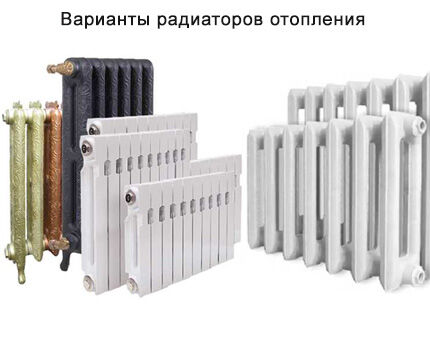
For each room, the number of radiators and their size will be different.It all depends on the area of the room, the level of insulation of the external walls of the building, the connection diagram, the thermal power indicated by the manufacturer in the product passport.
The location of the batteries is under the window, between windows located at a fairly long distance from each other, along a blank wall or in the corner of the room, in the hallway, pantry, bathroom, in the entrances of apartment buildings.

It is recommended to install between the wall and the heating device heat reflective screen. You can make it yourself using one of the heat-reflecting materials - penofol, isospan or another foil analogue.
You should also adhere to the following basic rules for installing a battery under a window:
- all radiators in one room are located on the same level;
- convector fins in a vertical position;
- the center of the heating equipment coincides with the center of the window or is 2 cm to the right (to the left);
- the length of the battery is at least 75% of the length of the window itself;
- the distance to the window sill is at least 5 cm, to the floor - no less than 6 cm. The optimal distance is 10-12 cm.
The level of heat transfer from devices and heat loss depends on the correct connection of radiators to the heating system in the house.
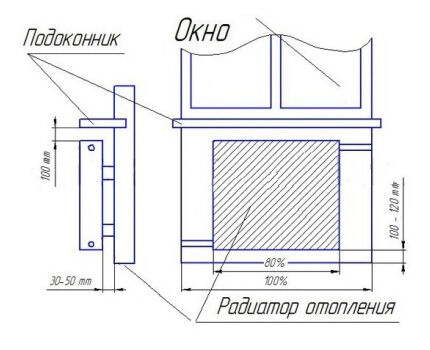
It happens that the owner of a home is guided by the advice of a friend, but the result is not at all as expected. Everything is done like his, but the batteries don’t want to heat up.
This means that the selected connection diagram was not suitable specifically for this house, the area of the premises, the thermal power of the heating devices were not taken into account, or annoying mistakes were made during installation.
Features of connection diagrams
There is a fundamental difference in the connection diagrams of heating devices depending on type of pipe routing. It can be single-pipe or double-pipe. Each of these types is divided into a system with horizontal mains or vertical risers.
Depending on the type of wiring chosen, the battery connection option will differ. For single-pipe and two-pipe systems it is possible to use side, bottom, diagonal connections of heating devices.
The main task is to choose the best option that can satisfy the needs of a particular home for the required amount of heat.
These two types of wiring refer to the tee pipe connection system. In addition to it, collector circuits are distinguished. They are also called beam wiring. Its main feature is the laying of a pipeline separately to each heating device.
The disadvantage is that the pipes pass directly through the premises of the entire floor and quite a lot of them will be required. This will affect the cost of the system. A significant plus is that they are most often mounted on the floor, without affecting the design of the room.

This option, which significantly increases pipe consumption, has recently been actively used in the design of heating circuits. The manifold connection of heating devices is used in the “warm floor” system.Depending on the type of project, it can serve as an additional source of heating or the main one.
Features of a single-pipe system
The type of heating in which all batteries are connected into one pipeline is called single-pipe. The heated and cooled coolant moves through one pipe, alternately entering all devices. It is important for it to choose the right diameter, otherwise the pipe will not cope with its duties and there will be no effect from such heating.
U single pipe system has its own disadvantages and advantages. Many novice craftsmen believe that by choosing this type of wiring, you can save a lot on the installation of heating devices and pipes. But this is a misconception. After all, for high-quality operation of the system, you will need to connect everything correctly, taking into account a lot of nuances. Otherwise the rooms will be cold.
A single-pipe system can really save money when using a vertical supply riser. This is relevant for 5-story buildings, where it is advantageous to install one pipe in order to reduce material consumption.
With this option, heated water flows upward through the main riser, and is further distributed throughout the remaining risers. The coolant enters the heating devices of each floor one by one, starting from the top.
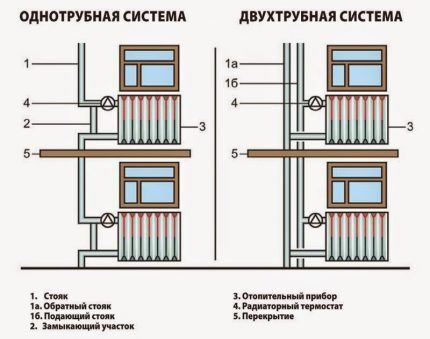
The lower the water falls, following the riser, the lower its temperature becomes. This problem is solved by increasing the area of radiators on the lower floors. It is advisable to equip radiators of a single-pipe system with bypasses.
This will make it possible to easily dismantle the heating device, for example, for repairs, without interfering with the functionality of the entire system.
In a single-pipe horizontal distribution system, you can use the associated or dead-end movement of the coolant. It works well for pipelines with a total length of up to 30 m. The optimal number of connected heating devices in this case is 4-5 pieces.
Two-pipe wiring: main differences
Two-pipe wiring involves the use of 2 pipelines: one for the passage of heated coolant (supply), the second for cooled coolant, which goes back to the heating tank (return). As a result, each battery receives water at approximately the same temperature, which allows all rooms to be heated evenly.
Usage two-pipe wiring considered the most desirable. With this connection of heating devices, the least heat loss occurs. Water circulation can be associated or dead-end.
This radiator maintenance system is characterized by convenient adjustment of their thermal performance.
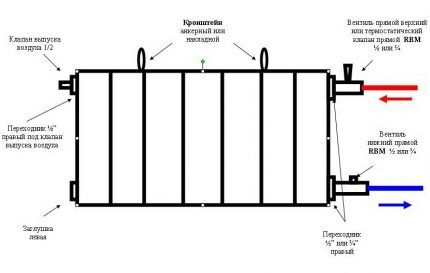
Many craftsmen who independently install the heating system of their home speak disapprovingly of the two-pipe system. The main argument is the high consumption of pipes, which significantly increases the cost of the project.
Upon closer examination of this statement, it turns out that if the devices are connected correctly and the optimal pipe diameters are used in a private house, the system will not cost much more than a single-pipe system.
After all, the installation of the latter requires a larger diameter of pipes and a larger area of devices.The final price will be affected by the cost of smaller diameter pipes, better coolant circulation and minimal heat loss.
Heating devices in a two-pipe system can be connected diagonally, from the side, or from below. It is permissible to use horizontal and vertical risers. The most effective option is a diagonal connection. It allows you to make maximum use of heat, distributing it evenly across all heating devices.
Side battery connection
Lateral connection is used in two- and one-pipe distributions. It is also called one-sided. The main feature is that the supply and return pipes are mounted on one side of the battery.
This system is used in multi-storey buildings with vertical coolant supply. The main condition is to install a jumper before connecting to the pipeline, called bypass, and taps, so that it is possible to remove the radiator without disturbing the entire system.
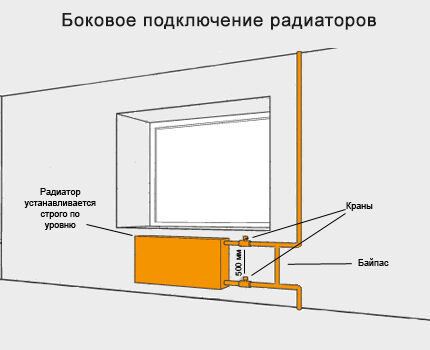
A one-way connection works most effectively with a short length of the heating device - 5-6 sections. Connecting long radiators in this way will result in large heat losses.
Specifics of the bottom connection
A scheme that uses a bottom connection is most often used to solve design problems. When you need to hide pipes by installing them in a wall or floor.
Manufacturers of heating devices offer various models and variations of radiators with bottom connection. The product data sheet indicates how to correctly connect a specific heating battery model.
Inside the radiator connection unit there are ball valves built in by the manufacturer, allowing it to be removed if necessary.Such information allows you to install devices into the system yourself.
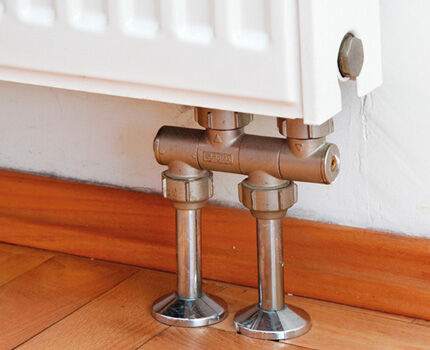
The bottom connection is not recommended for use with natural water circulation. High heat losses from the lower connection are compensated by higher power radiators.
Diagonal connection diagram
Diagonal connection is characterized by minimal heat loss. Its peculiarity is that heat is supplied from one side of the device, passes through all sections and exits through an opening on the other side. It is used for one- and two-pipe systems.
This option for connecting batteries can be implemented in two ways:
- Coolant enters the upper hole of the device, circulates through it and flows out of the lower side hole on the other side.
- Water enters the lower hole on one side and, having passed throughout the radiator, comes out of its upper opposite hole.
The diagonal circuit works effectively when connecting long batteries, with a total number of sections of 12 or more.
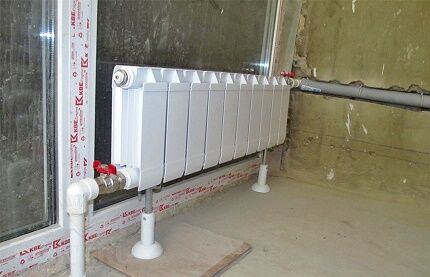
Natural or forced movement of water?
The battery connection option depends on what type of water or antifreeze movement is intended to be used for the operation of the system. There are only 2 options: natural circulation And forced.
The first option involves using physical laws without purchasing and installing additional devices. Suitable when the coolant is water. Any non-freezing agent will circulate worse in the system.
The system consists of a boiler that heats the water, an expansion tank, supply and return pipelines, and batteries. The water, heating up, expands and begins its movement along the riser, visiting the installed radiators in turn. The cooled water from the system flows by gravity back to the boiler.
With this circulation option, the horizontal pipeline is installed with a slight inclination towards the movement of the coolant. This system is self-regulating, because depending on the temperature of the water, its quantity also changes. The circulation pressure increases, allowing the water to heat the room evenly.
With natural circulation, two-pipe and one-pipe schemes with upper wiring, two-pipe with lower wiring are used. Such methods of connecting radiators to the heating system are beneficial for small rooms.
It is important to equip the batteries with air vents to remove excess air or install automatic air vents on the risers. It is best to place the boiler in the basement so that it is lower than the heated room.
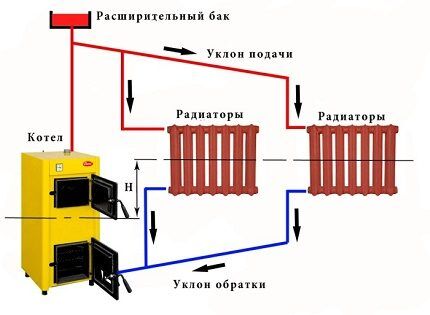
For houses with an area of 100 m2 and more, the coolant circulation system will have to be changed. In this case, you will need a special device that stimulates the movement of water or antifreeze through the pipes. We are talking about installation of a circulation pump. Its power depends on the area of the heated room.
The pump is installed on the supply or return pipeline. To remove excess air from the system, you will need to install automatic bleeders at the highest point of the pipeline or use batteries with Mayevsky cranes for manual bleeding.

The circulation pump is used in two- and one-pipe circuits with horizontal and vertical connection systems for heating devices.
Rules for connecting heating radiators
Regardless selected type of radiators and a suitable connection diagram for them, it is important to calculate and install everything correctly.
Each specific case will have its own optimal system. For expensive houses with a large area, it is advisable to contact specialists who can offer the optimal design. This is not an issue on which you need to skimp.

For small residential houses, you can independently choose a suitable scheme and install heating devices. It is imperative to take into account the features of your home, the rules for installing batteries and the feasibility of using one or another scheme.
When installing radiators, do not forget that the type of material for the battery itself and the pipes must be the same. Plastic pipes connected to cast iron heating devices will cause many problems, ruining the heating system.
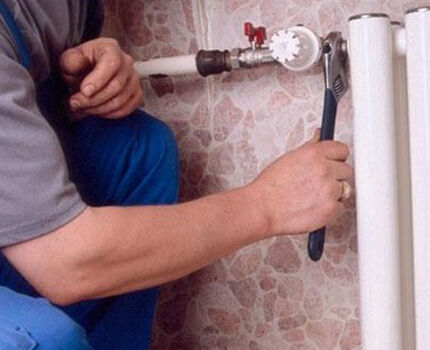
Conclusions and useful video on the topic
Video about the difference between natural and forced circulation of coolant in the heating system:
Video clearly demonstrating the differences between different heating system schemes:
Scheme for effectively connecting heating batteries with a two-pipe system:
The heating efficiency directly depends on the choice of battery connection diagram for your home. With the right option, heat loss is minimized. This allows you to get maximum effect with the least amount of fuel used. You can install the batteries yourself. It is important to take into account the construction features so that cold radiators do not interfere with a comfortable life in a cozy home.
If you are interested in the material we have proposed for consideration, have questions or a reason for discussion, we invite you to post comments.




Please tell me what to do if my radiator pipes directly “stick” to the wall of the house, is this not a minus? For example, when I was already doing putty at home myself, I noticed that it was not convenient, since I could not properly straighten the walls. And is it worth replacing old Soviet cast-iron radiators with new, but more beautiful steel or cast-iron appliances?
Good evening! I can say as an experienced plumber: in fact, you won’t feel the difference, but theoretically there is a difference. A tightly pressed battery will have significantly lower heat transfer. Well, something like this.
If there is no gap between the battery and the wall, then some of the heat goes through the wall to the street.If the batteries get hot, they are replaced only for aesthetics.
Good afternoon Please tell me, the apartment has floor heating: supply and return to each battery with a bottom connection (only 2 batteries in the apartment), there is a tee on the main line for the second battery. I want to redo it by installing a collector and connecting each battery with its own two-wire route. Is it possible to do this, and is it possible to change the battery connection from bottom to side or diagonal. The area of the rooms is 12 m2 and 18 m2. Which scheme will work more effectively in a family with two small children? Thank you!
Last year it was very cold, they called a plumber from the management company, he said that it was necessary to change the battery, it was cast iron. Replaced with an aluminum radiator, 14 sections, located under the window sill, single-pipe connection diagram. After changing the battery, almost nothing changed. The top was warm, and the bottom was getting colder. The airiness has been eliminated and it’s still cold at home. The area of the room is no more than 15 square meters. Where to go and what can be done?
Love, I also faced the same problem. It's all about the not quite correct connection of the radiator. It would be correct - a diagonal scheme. For example: hot feed enters the upper left battery connection node and exits from the lower right node. It is important that the serve always goes into the upper right or left. heater connection unit.
Good afternoon, Love. There are two options:
1. As you have already been told here, this is not a very good connection option. For clarity, the connection diagram is one-sided and two-sided. Compare with the real picture and draw conclusions.Please note that it does not have to be diagonal. Diagonally is considered to be the standard option.
2. The battery was replaced, but the old ball valve was left or the tee on the riser was not replaced. A fairly common mistake made by plumbers of management companies. This fact is related to cost. Replacing a faucet is much less expensive than replacing a battery. See diagram 3 clearly.
That is, when you bleed the air, the battery warms up evenly, picking up the coolant from the return. The moment you stop draining water/air, the battery cools down. This means that the internal cross-section of the pipe is narrowed by rust/deposits and the supply pressure in the system is not enough to push through the return and start natural circulation. In this case, initially the problem was not in the radiator, but in the pipes.
If you do this, the house will collapse!
Good afternoon. Single-pipe horizontal system, cast iron radiator, 14 sections, connected diagonally. The bottom quarter of the radiator is lukewarm. Tell me what's wrong?
Hello. Most likely, the reason is the accumulation of deposits in the lower part of the radiator. The type of wiring and connection has nothing to do with it. The calcium deposits that appear on the walls of the device have lower thermal conductivity, and therefore the heating is uneven. It is necessary to rinse with a reagent; radiators are washed separately from the system.
As a rule, there should be a so-called bypass. The most effective way is to place the response tap on this jumper; of course, you need to turn it off. This way we will achieve complete water circulation. But there is one caveat: when you shut off the battery, you must open the bypass, becauseWithout opening, stop the water circulation for other users who are hanging on this pipe. Everything will cool down for them too! This must be observed!
Good afternoon, Anton. The diagonal connection is the most efficient in terms of efficiency, but has one significant drawback - silting of the lower left or right corners, depending on the specific case. For clarity, I am attaching a diagram. In the vast majority of cases, the problem is solved by flushing without turning off the radiator.
You invite a plumber who will remove the bottom plug and install a stationary ball valve in its place.
The next steps are very simple:
- shut off the coolant supply;
— place the container and open the bottom tap;
— slowly open/close the supply as the container fills.
Carry out the procedure until it is completely cleaned. As the radiator is cleaned, the coolant will become transparent. Naturally, the plumber installs the faucet during the non-heating season, and flushing is carried out after the start of the heating season.
There is no cheaper way to resolve the issue. The advantage of this method is that in the future you will not have to resort to the help of a paid specialist.
If silting occurs at one corner of a diagonal connection, does this not indicate that the coolant is not circulating evenly? And why does the bottom connection on devices show uniform heating, while the diagonal connection shows a lower temperature in the bottom corner under the top feed?
Good afternoon, tell me please.I came across this nuance: a private house, a single-pipe heating system is divided into 3 circuits, each circuit has 6 batteries. Each circuit is approximately 36 meters, the pipe uses 32 plastic, and there is a circulation pump. Battery connections are both diagonal and bottom. I noticed that with a bottom connection the battery heats up completely evenly, but with a diagonal connection only the top is hot. What could be the problem? (I am not a professional)
First of all, I am attaching a diagonal connection diagram so that there is no misunderstanding. I’ll say right away that it is necessary to check the most common reason for the cold bottom of the radiator in this case - a blockage.
It could also be a problem with the shut-off valves, so don’t rule out that option. Low pressure can be ruled out since you have one circuit.
Did you design and connect the heating system yourself? It is possible that some mistakes have been made, which is why there is an effect where the bottom of the radiator remains cold.
What about convection? Heat always rises upward... Perhaps that is why when the radiator is connected diagonally, the lower corner on the supply side remains cold?
Water flows down equally through all channels. It’s just that with a diagonal connection, this corner gets clogged with garbage first... With a diagonal connection, the battery heats up more, but I prefer the bottom connection. The temperature is slightly lower, but the heating is uniform. And garbage does not accumulate below, because the flow...
Hello, help! Tell me, is it possible and how to weld radiators in the case as in the photo?
Hello.You can install radiators in the current wiring. As I understand it, the bottom is the return, so we will start from this. First of all, let's discuss what exactly you will need:
— the radiator itself, in this case cast iron is better;
— mountings for the radiator;
— adapters, taps, pipe fittings (metal, PP or PE, decide for yourself).
Now regarding the diagram according to which it is better to connect the radiator. I don’t see the whole picture of the heating system as a whole, but it is logical to assume that the system in this case will be two-pipe, so I deleted the one-pipe system from the proposed diagram. If possible, please draw a diagram of the current wiring to give a more accurate answer.
What problems will arise when connecting cast iron batteries (new type) with PVC pipes to a single-pipe system of a gas boiler with a pump?
If you connect everything correctly, use normal adapters and high-quality fittings, then no problems should arise. But regarding PVC, the question is: either you have a typo, or are you really planning to use PVC pipes? The fact is that low operating temperatures do not allow the use of PVC pipes in heating systems - this is a fact! The heat resistance of PVC pipes is only 65°C; glass transition occurs at a temperature of 75-80°C.
Therefore, in heating systems, PP (polypropylene) pipes are used, with a softening temperature starting from 130°C. However, the operating temperature at which the service life will not decrease is up to 95°C.
I am attaching a visual table of the operating temperatures of plastic pipes made of different materials, plus a table of the operating features of PP pipes at different temperatures.
But can it be done like in the photo?
No, you don't need to do that!
Good afternoon I can’t find information anywhere about what the length of the tube should be if the radiator is supposed to be installed in 10-12 sections. Tell?
Good day, Sergey. The length of the metal-plastic pipe (outer diameter 16) is equal to the length of the radiator minus one section.
Installed exclusively with a single-pipe system and a lateral radiator connection.
The intended purpose is to create a pseudo-diagonal connection effect.
It is used if the last sections do not warm up (note that only the issue of the cold top of the radiator is resolved, otherwise the flow extender will not eliminate the problem). If all sections of the radiator are heated evenly along the entire length, it is not recommended to install them “just in case.”
According to you, you are at the stage of selecting and then installing a new battery. Therefore, I would advise you not to rush into purchasing/installing a flow extender until you know for sure whether your specific situation requires it or not.
Why advertise a diagonal connection like that? One MINUS eats up all the imaginary advantages. Replacing the battery leads to chiselling of the walls. Do I need to explain why?
When it becomes necessary to replace the battery, it will be a big problem to find a battery with EXACTLY the same dimensions.So that the new one does not hang awry, you will have to play with pipes. And they are built into the wall. Hence the chiselling of walls.
Diagonal connection is an extremely bad solution.
Hello? This is the situation - one pipe goes around the house under the screed, and under each window there are leads to the battery sticking out. Will the batteries heat up if installed? The leads are simply soldered onto the tees.
Hello. My risers were replaced. The battery is new, bimetal. Top is hot, bottom is cold. Previously it was cast iron. And her top was hot, her bottom was warm. Two-pipe system. We installed taps in front of the battery. Why this result?
All new. The vertical risers used to be 15, now they are 20. After supplying water, the horizontal pipes to the battery were both hot, after a while the bottom one was cold. Water is supplied from above. Tell me why this is so?
Good afternoon, Anara. If we assume that everything is new, then the problem is the reduction in the diameter of the pipes from the riser, including on installed taps.
Water moves along the path of least resistance and the pressure in the home heating system is not enough to push through the return line. Coolant, to put it simply, flies past your radiators.
Good afternoon. Installed a new bi radiator for 18 sections. The connection is diagonal. Only the top and completely 2-3 sections from the exit side are heated. I'm thinking about a bottom connection. So at least the heat will rise up. How to make it work most efficiently. In the next room, a cast iron stove with 15 diagonal sections works perfectly.
Are you feeding from the top? Is the bypass set to a smaller diameter? Maximum for ball valves? Are the valves full bore and match the diameter of the main pipe? Is the air released?
Good afternoon, please tell me I have a two-pipe diagonal connection system (4 cast-iron central heating batteries) 2 of them are heated and the other is not. When I connect an additional hose to the last one on the drain and into the drain into the sink, all 4 heat up to the fullest, but as soon as you close the tap, then after a period of time 2 cool down again, you have to open the tap every time, what to do in this case
I have a connection in a five-story building, 5th floor, side connection, water supply from bottom to top. We want to replace the radiator with Harmony C40 2 and install PP pipes in the kitchen. Radiator of 12 sections. What is the best way to make a connection?
Good afternoon The apartment has floor heating: supply and return to each radiator with a bottom connection. Instead of one of the batteries, I would like to put two others: one under the window (low) and one against the wall. At the same time, the one under the window is planned with a side connection. Is it normal to make batteries with different connection types?
Hello! When replacing taps on heating radiators, extension cords were needed. Tell me how correctly they should be installed before the tap: pipe - extension - tap - radiator or should the extension be installed in front of the radiator after the tap (American)?
Good afternoon In the apartment (new building) the heating is on the floor with a bottom supply. The supply and return goes to each bottar with a bottom feed. The apartment is corner so the corner started to get damp. We want to add another battery to this corner. Tell me if it is possible to do this without affecting the floor since the repairs have already been made. And somehow stretch it from the battery, which is located nearby under the octave.
Good afternoon!!! Dear experts)) this connection turned out to be ineffective, the red designation is where it heats, but the blue one does not, bimetal radiators, the Royal company literally installed yesterday, a two-story residential building, we are on the first, supply from above, what can you advise? Can I redo it diagonally? like in the photo?
Please tell me if I have a horizontal two-pipe installation, I want to remove one battery completely. A local plumber recommends immediately looping the supply and return pipes. Is it correct? After all, in this case, water will always circulate to the maximum, regardless of the position of the thermostats of the remaining batteries. Will the meter spin like crazy?
Why does connection diagram “B” not work if there are more than 14 sections of heating radiators, even if you turn off the bypass tap? and what to do in this situation with a lateral connection. I heard that some kind of tube is inserted into the upper part of the radiator to heat the radiator evenly.
Low pressure in the system, valves are not full bore, air.